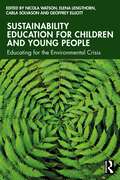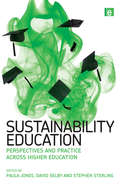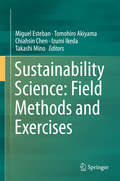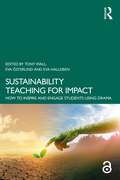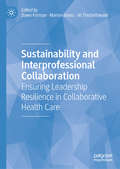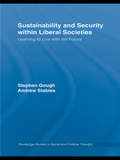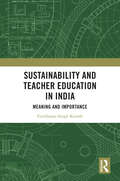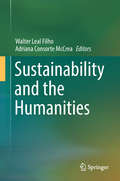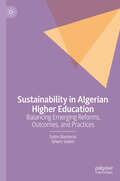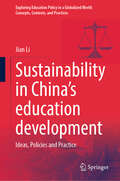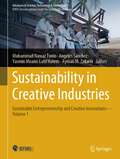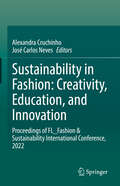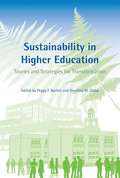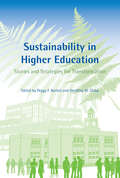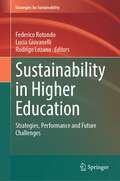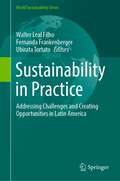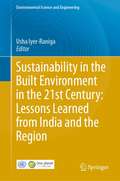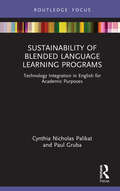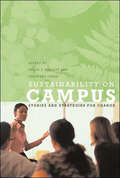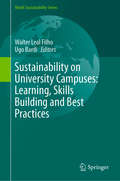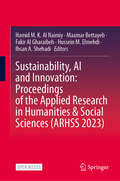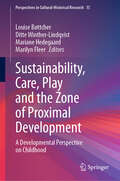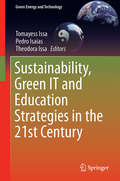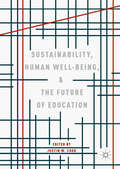- Table View
- List View
Sustainability Education for Children and Young People: Educating for the Environmental Crisis
by Carla Solvason Geoffrey Elliott Nicola Watson Elena LengthornThis seminal volume responds to the pressing need to prepare all children and young people for a sustainable future in light of the climate crisis, providing clear and accessible information and strategies on how to fully embed sustainability into pedagogy and supporting current and future educators.This book explores key environmental issues before exploring a range of pedagogies, each grounded in hope and exemplifying the principles of inclusion, empowerment, agency and social justice. Chapters explore major themes such as climate migration and displacement, climate activism, nature connectedness, sustainable leadership and eco‑anxiety to offer practical, scalable pedagogies that connect with the natural world. Designed to channel climate anxieties into energy for a reinvigorated, sustainable future of education, this book encourages an accessible and considered approach to classroom practice. Featuring contributions from wealth of international experts in the field, the volume ultimately provides a valuable resource for educators and students of education in all phases to develop the confidence to take an active lead in shaping education to help ensure a sustainable future.This book will appeal to educators, policymakers and researchers in environmental and sustainability education, teacher education, social justice education and educational leadership. Curriculum designers as well as those working across primary, secondary and higher education will also find the volume of interest.
Sustainability Education: Perspectives and Practice across Higher Education
by Stephen SterlingHow do we equip learners with the values, knowledge, skills, and motivation to help achieve economic, social and ecological well-being? How can universities make a major contribution towards a more sustainable future? Amid rising expectations on HE from professional associations, funders, policy makers, and undergraduates, and increasing interest amongst academics and senior management, a growing number of higher education institutions are taking the lead in embracing sustainability. This response does not only include greening the campus but also transforming curricula and teaching and learning. This book explains why this is necessary and - crucially - how to do it. Bringing together the experience of the HEFCE funded Centre for Sustainable Futures (CSF) at the University of Plymouth and the Higher Education Academy's Education for Sustainable Development Project, the book distills out the curriculum contributions of a wide range of disciplinary areas to sustainability. The first part of the book provides background on the current status of sustainability within higher education, including chapters discussing interdisciplinarity, international perspectives and pedagogy. The second part features 13 chapter case studies from teachers and lecturers in diverse disciplines, describing what has worked, how and why - and what hasn't. Whilst the book is organised by traditional disciplines, the authors and editors emphasise transferable lessons and interdisciplinarity so that readers can learn from examples outside their own area to embed sustainability within their own curricula and teaching. Subject areas covered include: geography, environmental and Earth Sciences, nursing/health, law, dance, drama, music, engineering, media and cultural studies, art and design, theology, social work, economics, languages, education, business and built environment.
Sustainability Science: Field Methods and Exercises
by Miguel Esteban Takashi Mino Tomohiro Akiyama Chiahsin Chen Izumi IkedaThis book builds up on the experience and lessons learnt by academics at the Graduate Program in Sustainability Science, Global Leadership Initiative (GPSS-GLI) at the University of Tokyo. A number of scholars in the new field of sustainability science describe how field methods and exercises are carried out in this discipline, together with the theoretical basis for such exercises. Case studies of various countries around the world where these exercises are carried out are showcased, emphasizing the various socio-economic considerations and problems facing humanity and possible ways forward to build more sustainable and resilient societies. The final objective is to enrich the field of sustainability science by describing the novel aspects used in the field exercises carried out by practitioners of this cross-disciplinary field.
Sustainability Teaching for Impact: How to Inspire and Engage Students Using Drama
by Tony Wall Eva Österlind Eva HallgrenSustainability Teaching for Impact is an essential step-by-step, practical guide for those wanting to inspire and engage higher education students in the areas of sustainability.This book encourages new and experienced university teachers across disciplines to adopt and adapt dramatic methods, with a view to develop their teaching. It introduces applied drama and performance arts methods that have been tried-and-tested across disciplines to deepen and broaden sustainability knowledge, skills, mindsets, and practices. Sustainability Teaching for Impact assumes no previous experience of the methods, as university teachers – with and without experience in drama – carefully walk you through some of the teaching practices they have used to create an impact in their teaching.This book is for higher and further education tutors who wish to build on their experience and deliver exciting and accessible classroom techniques and practices that are highly interactive, creative, and engaging to help further the teaching of sustainability.The Open Access version of this book, available at www.taylorfrancis.com, has been made available under a Creative Commons Creative Commons Attribution (CC-BY) 4.0 license.
Sustainability and Interprofessional Collaboration: Ensuring Leadership Resilience in Collaborative Health Care
by Marion Jones Jill Thistlethwaite Dawn FormanThis book is the fourth in the series on leadership, interprofessional education and practice, following on from Leadership Development for Interprofessional Education and Collaborative Practice (2014), Leadership and Collaboration: Further Developments for IPE and Collaborative Practice (2015) and Leading Research and Evaluation in Interprofessional Education and Collaborative Practice (2016). Along with policy changes around the globe, these three books have stimulated experts in this area to consider not only the ways in which they introduce and develop interprofessional education and collaborative practice, but also how they evaluate their impacts. In this 4th book, the focus is on the sustainability of these initiatives, sharing insights into factors that promote sustainability including leadership approaches and organisationsal resilience, as well as frequently encountered difficulties, and ways to overcome them.
Sustainability and Security within Liberal Societies: Learning to Live with the Future (Routledge Studies in Social and Political Thought #Vol. 58)
by Stephen Gough Andrew StablesMuch of the world will be living in broadly "liberal" societies for the foreseeable future. Sustainability and security, however defined, must therefore be considered in the context of such societies, yet there is very little significant literature that does so. Indeed, much ecologically-oriented literature is overtly anti-liberal, as have been some recent responses to security concerns. This book explores the implications for sustainability and security of a range of intellectual perspectives on liberalism, such as those offered by John Rawls, Robert Nozick, Frederick Hayek, Ronald Dworkin, Michael Oakeshott, Amartya Sen and Jürgen Habermas.
Sustainability and Teacher Education in India: Meaning and Importance
by Gursharan Singh KainthThis book provides an understanding of the importance of embedding and integrating the concept of sustainability into teacher education in India. It focuses on training teachers and educators towards achieving the principles of education for sustainability.The volume discusses the role of sustainability and its principles, in terms of its environmental, social, and economic dimensions in the professional development of teachers in the education system. It explains how teacher education is essential for introducing Education for Sustainable Development in school curriculums. It also highlights the role of sustainability in education for teachers in promoting environmentally responsible citizenship. While discussing the importance of training in-service and pre-service teachers to prepare them to implement such practices, it elucidates the meaning and significance of the National Curriculum Framework and its relationship with teacher education.This book will be of interest to teachers, students, and researchers of education, especially of teacher education, school education and education for sustainability. It will also be useful for academicians, educationalists, policymakers, teacher training institutes, and those preparing for competitive exams.
Sustainability and the Humanities
by Walter Leal Filho Adriana Consorte McCreaThis book explores the strong links between sustainability and the humanities, which go beyond the inclusion of social sciences in discussions on sustainability, and offers a holistic discussion on the intellectual and moral aspects of sustainable development. The contributions from researchers in the fields of education, social sciences, religion, humanities, and sustainable development fulfill three main aims:They provide university lecturers interested in humanities and sustainable development with an opportunity to present their work;foster the exchange of information, ideas and experiences acquired in the execution of teaching and research; anddiscuss methodological approaches and projects that provide a better understanding of how the humanities can contribute to the debate on sustainable development. Prepared by the Inter-University Sustainable Development Research Programme and the World Sustainable Development Research and Transfer Centre, the book reiterates the need to promote integrated approaches to sustainable development. Including practice-based lessons learnt that can be replicated further, it is a valuable resource for scientists and practitioners working in the humanities and sustainable development.
Sustainability in Algerian Higher Education: Balancing Emerging Reforms, Outcomes, and Practices
by Salim Bouherar Sihem SalemThis volume provides a comprehensive overview of the current state of sustainability in Algerian higher education. It examines the policies, initiatives, and practices that have been implemented across universities and other educational institutions, while also identifying the gaps and opportunities that remain. Through case studies, interviews, and analyses, the authors explore how these institutions are working to align their missions with the broader goals of sustainable development, and how they are contributing to the national and global discourse on sustainability.
Sustainability in China’s education development: Ideas, Policies and Practice (Exploring Education Policy in a Globalized World: Concepts, Contexts, and Practices)
by Jian LiThis book analyzes the concept of 'comprehensive educational sustainability in China' from the perspectives of ideas, policies, and practices. It provides a holistic overview of educational sustainability in China, covering topics such as: the sustainable life-circle model of teacher education policy, the quest for sustainable basic education reform, the sustainable development of vocational education and higher education, and teacher exchange and rotation policy for sustainable education reforms. This book serves as a valuable resource for scholars and researchers who are interested in/working on research on educational sustainability in China, as well as administrators and stakeholders in the Chinese international education system, and graduate students who major or minor in the field of sustainable education.
Sustainability in Creative Industries: Sustainable Entrepreneurship and Creative Innovations—Volume 1 (Advances in Science, Technology & Innovation)
by Muhammad Nawaz Tunio Angeles Sánchez Yasmin Moanis Latif Hatem Ayman M. ZakariaThis book discusses a compelling array of topics at the intersection of entrepreneurship, education, and technological innovation within the creative industries. It delves into a captivating exploration of sustainable entrepreneurship in Part 1, where key characteristics of sustainable entrepreneurs and factors influencing entrepreneurial intention are dissected. By unearthing the nexus between entrepreneurial alertness, networking capability, and venture performance, it provides intriguing insights into sustaining traditional crafts and brands amid the COVID-19 pandemic. The following parts not only unveil current innovative pedagogical strategies in creative design education but propels you into the future, exploring the harmonious fusion of academia and industry in sustainability-driven programs. Designed for educators, students, researchers, and practitioners in entrepreneurship, design, and technology fields, this book offers a transformative journey into sustainable practices, innovative pedagogies, and cutting-edge advancements. Engaging, informative, and thought-provoking, it is a must-read for those seeking to shape the future of creative industries through entrepreneurship, education, and innovation.
Sustainability in Fashion: Proceedings of FL_Fashion & Sustainability International Conference, 2022
by Alexandra Cruchinho José Carlos NevesSustainability in Fashion: Creativity, Education, and Innovation is a book that focuses on how sustainability can be integrated into the fashion and clothing industry. The set of chapters provides peer-reviewed research covering a wide range of topics, mainly focused on how sustainability can be incorporated into fashion and textile education, how consumer behaviour and marketing affect sustainability in fashion (and vice versa) and how circular economy principles can be incorporated into clothing and textile supply chains. The chapters in this proceedings volume examine sustainability not only from the perspective of academia, but also from the perspective of industry. Working across sectors in this manner can facilitate the development of real projects that can greatly contribute to sustainability in the fashion industry.
Sustainability in Higher Education
by Peggy F. Barlett Geoffrey W. ChaseIn colleges and universities across the United States, students, faculty, and staff are forging new paths to sustainability. From private liberal arts colleges to major research institutions to community colleges, sustainability concerns are being integrated into curricula, policies, and programs. New divisions, degree programs, and courses of study cross traditional disciplinary boundaries; Sustainability Councils become part of campus governance; and new sustainability issues link to historic social and educational missions. In this book, leaders from twenty-four colleges and universities offer their stories of institutional and personal transformation. These stories document both the power of leadership -- whether by college presidents, faculty, staff, or student activists -- and the potential for institutions to redefine themselves. Chapters recount, among other things, how inclusive campus governance helped mobilize students at the University of South Carolina; how a course at the Menominee Nations tribal college linked sustainability and traditional knowledge; how the president of Furman University convinced a conservative campus community to make sustainability a strategic priority; how students at San Diego State University built sustainability into future governance while financing a LEED platinum-certified student center; and how sustainability transformed pedagogy in a lecture class at Penn State. As this book makes clear, there are many paths to sustainability in higher education. These stories offer a snapshot of what has been accomplished and a roadmap to what is possible. Colleges and Universities covered include Arizona State University - Central College, Iowa - College of the Menominee Nation, Wisconsin - Curriculum for the Bio-region Project, Pacific Northwest - Drury University, Missouri - Emory University, Georgia - Florida A&M University - Furman University, South Carolina - Green Mountain College, Vermont - Kapolani Community College, Honolulu, Hawaii - Pennsylvania State University -San Diego State University - Santa Clara University, California - Slippery Rock State University, Pennsylvania - Spelman College, Georgia - Unity College, Maine - University of Hawaii--Manoa - University of Michigan - University of South Carolina - University of South Florida - University of Wisconsin--Oshkosh - Warren Wilson College, North Carolina - Yale University
Sustainability in Higher Education: Stories and Strategies for Transformation (Urban and Industrial Environments)
by Peggy F. Barlett Geoffrey W. ChaseCampus leaders describe how community colleges, publicly funded universities, and private liberal arts colleges across America are integrating sustainability into curriculum, policies, and programs.In colleges and universities across the United States, students, faculty, and staff are forging new paths to sustainability. From private liberal arts colleges to major research institutions to community colleges, sustainability concerns are being integrated into curricula, policies, and programs. New divisions, degree programs, and courses of study cross traditional disciplinary boundaries; Sustainability Councils become part of campus governance; and new sustainability issues link to historic social and educational missions. In this book, leaders from twenty-four colleges and universities offer their stories of institutional and personal transformation. These stories document both the power of leadership—whether by college presidents, faculty, staff, or student activists—and the potential for institutions to redefine themselves. Chapters recount, among other things, how inclusive campus governance helped mobilize students at the University of South Carolina; how a course at the Menominee Nation's tribal college linked sustainability and traditional knowledge; how the president of Furman University convinced a conservative campus community to make sustainability a strategic priority; how students at San Diego State University built sustainability into future governance while financing a LEED platinum-certified student center; and how sustainability transformed pedagogy in a lecture class at Penn State. As this book makes clear, there are many paths to sustainability in higher education. These stories offer a snapshot of what has been accomplished and a roadmap to what is possible.Colleges and Universities CoveredArizona State University • Central College, Iowa • College of the Menominee Nation, Wisconsin • Curriculum for the Bio-region Project, Pacific Northwest • Drury University, Missouri • Emory University, Georgia • Florida A&M University • Furman University, South Carolina • Green Mountain College, Vermont • Kap'olani Community College, Honolulu, Hawaii • Pennsylvania State University •San Diego State University • Santa Clara University, California • Slippery Rock State University, Pennsylvania • Spelman College, Georgia • Unity College, Maine • University of Hawaii–Manoa • University of Michigan • University of South Carolina • University of South Florida • University of Wisconsin–Oshkosh • Warren Wilson College, North Carolina • Yale University
Sustainability in Higher Education: Strategies, Performance and Future Challenges (Strategies for Sustainability)
by Rodrigo Lozano Federico Rotondo Lucia GiovanelliThis contributed volume addresses the issue of how higher education institutions can systematically reorient themselves to help society become more sustainable. In particular, a strategic management approach is used to overcome the fragmentation of sustainability initiatives increasingly conducted by higher education institutions worldwide. In this book, eminent scholars in the field of sustainability in higher education combine their different backgrounds to propose conceptual frameworks for interpreting and measuring sustainability integration in higher education institutions. The chapters contained herein explore which processes and management tools should be used, as well the challenges to be faced, to make sustainable innovation effective. The cases present in this volume offer a guide for higher education institution management to lead the sustainability transition.
Sustainability in Practice: Addressing Challenges and Creating Opportunities in Latin America (World Sustainability Series)
by Walter Leal Filho Fernanda Frankenberger Ubirata TortatoSustainability is now a widely spread concept, and much progress has been achieved since the 1970s, when it started to be widely discussed. At present, many international organizations and scientists are active in implementing sustainable development as a whole and the UN Sustainable Development Goals (SDGs) in particular. Nevertheless, the main research agenda is being led by some countries, providing a good opportunity for other nations and regions which have not yet been so active, to bring their viewpoints to the global discussion. One of these regions is Latin America. Consistent with the need for more cross-sectorial and cross-cultural interactions among the various stakeholders working in the field of sustainability in Latin America and beyond, this book pursues two main aims: a) to provide research institutions, universities, NGOs, government agencies, and enterprises from the region with an opportunity to present their works in the field of sustainability and b) to document and promote ideas and experiences acquired in the execution of sustainability projects, especially successful initiatives and good practice across the Latin America region. Last but not least, a further aim of the book is to present methodological approaches and experiences deriving from case studies and projects, which aim to show how sustainability may be enhanced in practice.
Sustainability in the Built Environment in the 21st Century: Lessons Learned from India and the Region (Environmental Science and Engineering)
by Usha Iyer-RanigaThis book follows on previous works addressing sustainable development research in the Asia-Pacific region. It mainly focuses on India, a country currently facing immense challenges in the form of climate change, rapid urbanisation, and population pressures in its journey to help achieve the Sustainable Development Goals. Expecting to surpass China in terms of population in the near future, India needs to develop its own solutions in order to uphold its commitments under the Paris Agreement. This book makes a contribution in that direction by presenting case studies on various aspects of the built environment, from education to managing cities, procurement, and considerations for a circular economy. The papers gathered here offer a vital resource for government policymakers, educators, and current and future professionals, equipping them with the knowledge and expertise they need in order to overcome today’s complex challenges in the built environment.
Sustainability of Blended Language Learning Programs: Technology Integration in English for Academic Purposes (Routledge Focus on Applied Linguistics)
by Paul Gruba Cynthia Nicholas PalikatThis book focuses on the investigation of the sustainability of technology integration in the context of language programs and is based around an 18-month longitudinal study of a blended EAP (English for Academic Purposes) language program situated within a university pathways course. The integration of technology into language teaching and learning in academic English programs often demands substantial investment in professional development, curriculum change, and technological resources. Given the intense effort required, sustainability of such efforts has gained importance, focus, and urgency. Situated in the context of English for Academic Purposes (EAP) programs, this book frames, and investigates, the sustainability of technology integration through a series of case studies of specific technologies: tablet devices, a Learning Management System, and an interactive presentation app. The authors explore sustainable integration of technology; the use of argument-based approaches as a basis for research design; and participant ethnography as a form of data collection. The book concludes by looking at the implications of the research and proposes that change management concepts be applied to better introduce, implement, and most importantly, sustain change involving educational technology integration. The content will be of interest to scholars in TESOL and applied linguistics as well as professional language educators who will benefit from insights into sustaining technology integration in their programs.
Sustainability on Campus: Stories and Strategies for Change (Urban and Industrial Environments)
by Peggy F. Barlett Geoffrey W. ChaseStories both practical and inspirational about environmental leadership on campus.These personal narratives of greening college campuses offer inspiration, motivation, and practical advice. Written by faculty, staff, administrators, and a student, from varying perspectives and reflecting divergent experiences, these stories also map the growing strength of a national movement toward environmental responsibility on campus.Environmental awareness on college and university campuses began with the celebratory consciousness-raising of Earth Day, 1970. Since then environmental action on campus has been both global (in research and policy formation) and local (in efforts to make specific environmental improvements on campuses). The stories in this book show that achieving environmental sustainability is not a matter of applying the formulas of risk management or engineering technology but part of what the editors call "the messy reality of participatory engagement in cultural transformation."In Sustainability on Campus campus leaders recount inspiring stories of strategies that moved eighteen colleges and universities toward a more sustainable future. This book is for faculty, students, administrators, staff, and community partners, whether hesitant or committed, knowledgeable or newcomer. Scholars and activists have recognized the crucial role that higher education can play in the sustainability effort, and each chapter in the book is full of ideas about how to get started, revitalize efforts, and overcome roadblocks. Human and at times joyful, these stories illustrate many forms of leadership, in new courses and faculty development, green buildings and administrative policies, student programs, residential life, and collaborations with local communities.
Sustainability on University Campuses: Learning, Skills Building and Best Practices (World Sustainability Series)
by Ugo Bardi Walter Leal FilhoThe implementation of sustainability initiatives on campuses is an essential component of promoting sustainability in the higher education context. In addition to reflecting an awareness of environmental issues, campus programmes demonstrate how seriously universities take sustainability at the institutional level.There is a lack of truly interdisciplinary publications that comprehensively address the issue of campus greening, and there is an even greater need for publications that do so at a truly international level. This book meets these needs. It is one of the outcomes of the “Second Symposium on Sustainability in University Campuses” (SSUC-2018), which was jointly organised by the University of Florence (Italy), Manchester Metropolitan University (UK), the Research and Transfer Centre “Sustainable Development and Climate Change Management” and the “European School of Sustainability Science and Research” at the Hamburg University of Applied Sciences (Germany), in cooperation with the Inter-University Sustainable Development Research Programme (IUSDRP).The book showcases examples of campus-based research and teaching projects, regenerative campus design, low-carbon and zero-carbon buildings, waste prevention, and resilient transport, among others. Ultimately, it demonstrates the role of campuses as platforms for transformative social learning and research, and explores the means by which university campuses can be made more sustainable.The aims of this publication are as follows:• to provide universities with essential information on campus greening and sustainable campus development initiatives from around the world;• to share ideas and lessons learned in the course of research, teaching and projects on campus greening and design, especially successful initiatives and good practice; and• to introduce methodological approaches and projects intended to integrate the topic of sustainable development in campus design and operations.This book gathers contributions from researchers and practitioners in the field of campus greening and sustainable development in the widest sense, from business and economics, to the arts, administration and the environment, and hailing from Europe, Latin America, North America and Asia.
Sustainability, AI and Innovation: Proceedings of the Applied Research in Humanities & Social Sciences (ARHSS 2023)
by Hamid M. K. Al Naimiy Maamar Bettayeb Hussein M. Elmehdi Ihsan A. Shehadi Fakir Al GharaibehThis open-access book presents the proceedings of the first 1st International Conference on Applied Research in Humanities & Social Sciences (ARHSS) held from Oct 31 to Nov 02, 2023, at the University of Sharjah, United Arab Emirates. It showcases the latest advances in research related to digital, ethical, and advanced crime prevention and enhancing social security. In addition, the topics include sustainability and innovation in economy, society, and governance (ESGs). The topics also tackle current issues, focusing on Artificial Intelligence (AI) and its wide applications in humanities and social sciences. Given its scope, the book is essential for scholars, students, policy-makers, and education practitioners interested in better keeping up with the latest advances in this critical field.
Sustainability, Care, Play and the Zone of Proximal Development: A Developmental Perspective on Childhood (Perspectives in Cultural-Historical Research #15)
by Marilyn Fleer Mariane Hedegaard Ditte Winther-Lindqvist Louise BøttcherThis book addresses the central issue of children’s social situation of development in relation to sustainability, care and imagination. The concept of sustainability is topical in current societal discussions, but much in need of further elaboration, which is provided by this book as an integrated aspect of childcare and child development. It provides an exploration of whether and how sustainability can contribute relevantly to conceptual development within the cultural-historical framework with relation to child development more broadly and care and imagination more specifically. A central question in the book is how the concept of sustainability is related to Vygotsky’s writings on the zone of proximal development and the social situation of development. It takes on the current need to understand the problem of creating more sustainable societies and practices as interconnected practices for supporting the development of children as present and future sustainability-responsible citizens. This book provides a much needed theoretical elaboration of child care as a scientific concept, the practice context of care, and a wholistic conceptual approach to care.
Sustainability, Green IT and Education Strategies in the Twenty-first Century
by Pedro Isaias Tomayess Issa Theodora IssaThis work presents and discusses the latest approaches and strategies for implementing Sustainability and Green IT into higher education and business environments. Following the global financial crisis in 2007/2008, businesses began to struggle coping with the increased IT/IS cost and their environmental footprint. As a consequence, action by universities to incorporate sustainability and ‘Green IT’ as parts of their teaching and learning materials, acknowledging their importance for global and local businesses, is being increasingly implemented. The book addresses the cooperation and coordination between academics and practitioners needed in order to achieve the changes required to obtain sustainability.Intended for researchers, lecturers and post-graduate students, as well as professionals in the Information Society and ICT and education sectors, and policy makers.
Sustainability, Human Well-Being, and the Future of Education
by Justin W. CookThis open access book explores the key dimensions of a future education system designed to enable individuals, schools, and communities to achieve the twin twenty-first century challenges of sustainability and human well-being. For much of the twentieth century, Western education systems prepared students to enter the workforce, contribute to society and succeed in relatively predictable contexts. Today, people are at the controls of the planet—making decisions that are dramatically reshaping social, economic, and environmental systems at a global scale. What is education’s purpose in this new reality? What and how must we learn now? The volatility and uncertainty caused by digitalization, globalization, and climate change weave a common backdrop through each chapter. Using case studies drawn from Finland and the US, chapter authors explore various aspects of learning and education system design through the lenses of sustainability and human well-being to evaluate how our understanding and practice of education must transform. Using their scholarly research and experience as practitioners, the authors propose new approaches to preparing learners for a new frontier of the human experience fraught with risks but full of opportunity.
Sustainability: A Bedford Spotlight Reader
by Christian R. WeisserSustainability explores questions around the central concept of sustainability: What are its foundations and politics? How do crises challenge sustainability? How is sustainability connected to local and transnational environments? How is sustainability connected to tourism and recreation? Readings by a range of ecologists, urban planners, philosophers, geographers, reporters, artists, and ordinary citizens take up these questions and more. Questions and assignments for each selection provide a range of activities for students. The website for the Spotlight Series offers comprehensive instructor support with sample syllabi and additional teaching resources. The Bedford Spotlight Reader Series is an exciting line of single-theme readers, each reflecting Bedford’s trademark care and quality. An editorial board of a dozen compositionists at schools with courses focusing on specific themes assists in the development of the series. Each reader collects thoughtfully chosen selections sufficient for an entire writing course—about 35 pieces—to allow instructors to provide carefully developed, high-quality instruction at an affordable price. Bedford Spotlight Readers are designed to help students from all majors make sustained inquiries from multiple perspectives, opening up topics such as money, food, border crossings, music, humor, subcultures, happiness, monsters, sustainability, and gender to critical analysis. The readers are flexibly arranged in thematic chapters, with each chapter focusing in depth on a different facet of the central topic. The website for the Spotlight Series offers comprehensive instructor support with sample syllabi and additional teaching resources.
